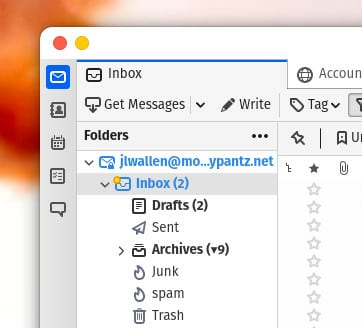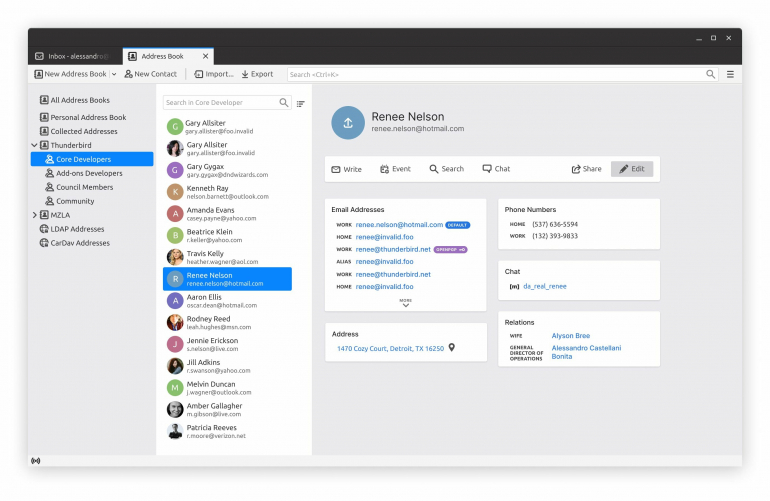Although the upcoming major release of Thunderbird isn’t about drastic changes, what it does have to offer makes the workflow much more efficient than previous iterations. Jack Wallen has the details.

With the exception of Gmail, I prefer a traditional desktop email client over web-based versions. There are many reasons for this, but the primary is that I work with numerous email accounts throughout the day and I don’t want to have to deal with a Firefox tab for each. Ergo … I opt to go the desktop email client route to better manage those accounts.
For decades, I’ve used Thunderbird as my desktop email client of choice. Part of the reason for that is it’s simply the best option for the Linux desktop. Another reason is that, although a bit long in the tooth, the UI is quite efficient to use. That’s right, Thunderbird isn’t exactly the most modern-looking tool on my desktop. Quite the opposite. The Thunderbird I used today isn’t much different than the one I used a decade ago. That’s fine because it works well enough for me to shrug off the outdated interface.
SEE: 40+ open source and Linux terms you need to know (TechRepublic Premium)
If the developers of Thunderbird have their way, version 102 of the application might finally modernize that UI. Before you get too excited, what’s coming down the pike isn’t a tectonic shift for the software. Instead, the developers went for a few subtle tweaks in the design and added a handy sidebar to make it easier to switch between features.
The last major release of Thunderbird was version 91, back in August 2021, which mostly offered security updates and bug fixes. With the upcoming version 102, users will enjoy several new features that come together to help bring the open-source email client into the modern age.
Almost.
Some of these new features have already crept their way into the Thunderbird Nightly build. I’ve been working with the nightly version (now at release 101.0a1). Unfortunately, not all of the features have made their way into the Nightly build. With that said, let’s take a look at the features that are now ready to test.
The Spaces Toolbar in Thunderbird 102
In my opinion, this is the biggest addition to Thunderbird. The new Spaces Toolbar (Figure A) is a sidebar that gives you quick access to some of the Thunderbird features (Email, Contacts, Calendar, Tasks and Chat).
Figure A

This new Spaces Toolbar aligns the application with full-blown groupware tools like Enlightenment (on Linux) and Outlook (on Windows). By making it easier for users to access those tools, the Thunderbird workflow is much improved. Not only do you get access to those tools, but at the bottom of the Spaces Toolbar, you’ll find a gear icon that opens the Thunderbird Settings window. No more having to access settings from the hamburger menu.
When you click on an icon in the Spaces Toolbar, Thunderbird will open a new tab for that service, which is how the email client has always worked. So, truthfully, the biggest difference is that you have faster access to opening the features than you did before. Prior to the Spaces Toolbar, you’d have to hunt down the various launchers for each tool (as they weren’t centrally located).
The New Addressbook in Thunderbird 102
Thunderbird 102 will arrive with a completely retooled address book (Figure B). As of this writing, the new address book has yet to show itself in the Nightly Build, but the developers have made it clear their goal is to make it considerably easier to navigate and interact with the contacts you’ve saved. The new address book breaks each contact into cards, one each for:
- Email addresses
- Phone numbers
- Addresses
- Chat information
- Relations
Figure B

You will also find what looks like an action bar for each contact that gives you quick access to composing an email to a contact, creating an event with a contact, searching for communication with a contact, and sharing a contact’s details.
The smaller improvements in Thunderbird 102
Truth be told, that’s it for the major changes coming to Thunderbird. Outside of that, you can look for these new improvements/features:
- Link preview cards will create small preview cards for links you add to an email.
- Account Setup Hub makes it just as easy to add secondary email accounts as it is to add the initial account.
- Matrix support is now added by default and doesn’t have to be enabled via the Settings window (as it nowrequires).
- Import/export is now integrated into the core of Thunderbird, so there’s no need to install third-party add ons.
- Message headers have been redesigned to make it easier to discern the information you need from the header of an email.
All-in-all, the upcoming Thunderbird looks to offer just enough new features and UX redesign to reinvent an aging email client. No, this isn’t a profound deal-making or deal-breaking update, but given how well Thunderbird works, there’s no reason to fix what’s not broken. Although I was a bit disappointed that the overall UI hasn’t been dramatically improved to bring it more in line with modern aesthetics, I’m just happy Thunderbird is still going strong. Hopefully, Thunderbird will stick around for years to come.
Subscribe to TechRepublic’s How To Make Tech Work on YouTube for all the latest tech advice for business pros from Jack Wallen.
Source of Article



